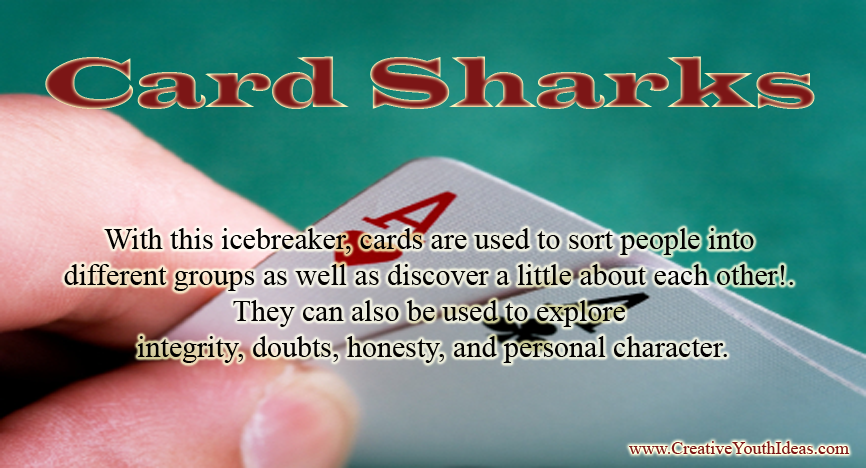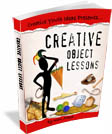Decks of cards are easy to find. And everyone knows a card game or two. With this icebreaker, cards are used to sort people into different groups as well as discover a little about each other! They can also be used to explore integrity, doubts, honesty, and personal character.

PLEASE SHARE “CARD SHARKS” ON FACEBOOK – CLICK HERE
What You Need
Deck of normal playing cards. Add additional decks for larger groups. I have found boxes of enormously sized cards at novelty shops that add even more fun to the games. I’ve even found them as large as an 8-1/2 x 11 sheet of paper.
Using Playing cards to Breaking into Groups
Shuffle cards and let each youth choose one. (You can reduce the size of a deck to your group side by removing some of the numbers of each suit. Once youth have chosen cards, you can force specific combinations of youth by telling them to group themselves in the following ways:
* Red vs Black – Two Teams according to the color of the cards
* Odds & Evens – Two teams according to the value of cards (Face cards have the values Jack-11, Queen – 12, and King – 13)
* Suits – Four teams (Spades, Hearts, Diamonds, Clubs)
* Call out any number and they must form groups that add up to that number.
* BlackJack – Add up to 21
* Poker Hands – Groups of 5 cards (Which group has the highest hand?)
– Four of a Kind – All four cards of each number (groups of four)
– Straight Flush – 5 Cards Grouped by Colors and lined up according to number.
– Full House – 3 of one card and two of another
– 3 of a kind – 3 cards of same number, 2 additional cards
– 4 of a kind – 4 cards of same number, 1 additional card
– Straight – 5 cards in order
– Flush – 5 cards of the same color
– Two Pairs – 2 sets of two plus another card
Games using Playing Cards
- Build a Tower – Give groups of youth a deck or two of playing cards, inside a box, and ask them to build the tallest tower in a given period of time. Do not say it is a competition between groups. Just that in X minutes the tallest tower wins. The tallest tower could actually be built when they put all their resources together. What lessons can we learn from this?
- Card elimination – When you call out specific groupings of cards (or poker hands), The youth must scramble to form them. If groups do not meet the specified criteria or are the last group to form, they are eliminated from the game. The last remaining group is the winner.
- Card Identity – Ask students to pick cards from the deck that represent something about themselves. These representations can be as shallow or deep as the students’ imaginations. Have youth mingle and share with one another their names and the cards they have chosen and why. One might choose a two because they have “2 parents” or “two feet” etc. Another student might choose an ace because they strive to “be an ‘ace’ at everything they do… The opportunities are limitless.
- Card Mixer – Before the activity, write a question on each card to be shared when the youth are mixing together. (e.g. what is your favorite ice cream, most embarrassing moment, favorite musician, favorite scripture, etc.) Match these questions to a future discussion!
- Go Fish! – 5 cards are dealt to each player. In turn, players ask another player for his/her cards of a specific rank. (Example: “Ken, do you have threes?”) A player may only ask for a card of which he already holds at least 1 card.The person asked must hand over all cards of that rank. If the call was successful, the player has another turn. But if the player asked has no cards of that rank, he says “Go fish”, and the asking player draws the top card from the deck and it’s the next player’s turn. When a player has all 4 cards of a rank they are placed face up on the table. The game ends when all sets are formed, and the player with the most cards wins.
- Playing Card LIne-up – Instruct the youth to not peek at their cards, then pass out one playing card to each member of the group (you may need a few decks …). On your signal, each youth places the card on their forehead so that others can see the card. Without talking, all youth then group by suit, and then in numerical order (Is Ace high or low? ) Instead of placing them on their forehead where they can fall off, you can also punch a hole in each card and hand them on a strong around the youth’s necks so that it hangs in the back where they cannot see it but others can. What worked or didn’t? Who were the leaders? What are some lessons?
- Stratego – Play a variation of “stratego” between two teams. Remove cards from the deck so that there is 1-ace, 2-two’s, 3 three’s, etc. Designate jokers as bombs. Leave only one king. The king can be captured by any card. Use the jack with the sword to his head as the spy. Play the game just as you would “stratego”, but have teams send representatives to a person on the opposing team to do battle. Do not reveal the card numbers to teams, but merely who is the victor of the battle. Those who lose battle cannot reveal the victors total to their teams and are removed to a graveyard area. First team to kill the king wins.
- Team Sit – Give each team a suit of cards, shuffled and one chair. On your signal, players look at their cards and without talking the ace takes the chair. 2 sits on their knees. 3 sits on the next person’s knees. First team to sit in a line wins.
- Ten – Remove 10s and all face cards. Have students choose a partner whose card added to theirs will result in a sum of 10… the combinations are numerous (1-9, 2-8, 3-7, 4-6, 5-5) Last cuple to pair up is eliminated. Blindly exchange cards with at least 3 people then have then go again , repeating until you have a winner.
A Card Game and a Lesson
Play a game of “I Doubt It” it with the cards.
- Divide into 2 to 4 teams.
- In this game the objective is to be the first team to discard all of their cards. The team who goes first must discard their aces face down, the second two’s, third, three’s… through King’s. Each time play comes back to the team, a new player must place the cards down, rotating through team members.
- As the team places the cards down they must announce the quantity of cards being played (i.e. 2 aces, 1 two, 3 threes, 1 jack, 4 queens, etc.) If a team doesn’t have a card of the value they are supposed to play, then they must bluff.
- A team may also bluff at any time by including additional cards of another value in with the cards of the correct value they are playing. For example a person may only have two aces, but includes a six and calls out “three aces.”
- At any time another team may shout “I doubt it.” The team that just played cards must turn them over and reveal them. If the revealed cards were a bluff and not 100% what they were claimed to be, the team picks up the entire discard pile. If they were telling the truth, then the team who yelled “I doubt it” must pick up the entire discard pile.
- The game continues until one team runs out of cards.
TAKE IT TO THE NEXT LEVEL
Discussion
- What is the primary objective of the card game “I doubt it”? What are some of our objectives in life? What does winning mean to you?
- What type of person is best at this game? Did anyone in this game get a reputation for dishonesty or for integrity? What reputation do you have with others? How did you get that reputation?
- What elements of this game caused you to lie, misrepresent the truth, or stretch the truth? What things tempt you to be less than honest in real life? What things tempt you to act against your normal character?
- Are you known for your honesty, for your integrity? What actions in life build / destroy a person’s character / reputation? Why is a good reputation important? How does our reputation affect how others respond to us?
- Is TRUTH flexible? Why or why not? Is there such a thing as absolute truth? Why or why not?
MAKE IT SPIRITUAL
INTEGRITY: How often in life do we try to gain – benefit by either stretching the truth or by an outright lie? How many times do we sacrifice honesty and integrity to get ahead of others in the game of life? While in this game we might get away with it do people get away with it in life? Is integrity really important? Honesty?
Why is integrity important to God? (1 Kings 9:4, 1 Chronicles 29:17, Job 2:2-4, Titus 2:7, Proverbs 10:9)
Instances of integrity in the Bible:
- Jacob, in the care of Laban’s property (Genesis 31:39)
- Joseph, in resisting Potiphar’s wife (Genesis 39:8-12, 40:15)
- Moses, took nothing from the Israelites for his services (Numbers 16:15)
- Samuel, in took nothing from the people for his services (1 Samuel 12:4)
- David, in self-reproach for the cutting of Saul’s robe (1 Samuel 24:5)
- Daniel, in staying pure and upright (Daniel 1:8-20; Daniel 6:4)
- Nathanael, in whom was no guile (John 1:47)
- Peter, when offered money by Simon Magus (Acts 8:18-23)
DOUBTS: All of us have doubts at one time or another, but that doesn’t mean we give up. We make choices the best we can not knowing what the next card in life holds for us.
What are some of your doubts related to the Bible and your faith?
Divided the youth into groups to write a short monologues of doubts that the following Biblical characters might have had:
- The disciples when caught on the sea in storm (Mark 4:26-40)
- Noah when he was asked to build the ark (Genesis 6,7)
- Abraham when asked to sacrifice Isaac (Genesis 22:1-10)
- Moses when God asked him to go to Pharoah (Ex. 4:1-13)
- David when he faced Goliath (I Samuel 17,18)
- Daniel when he was thrown to the lion’s den (Daniel 6)
- What options did the above people have in responding to their doubts? Why do you think they acted as they did?
- How could you rewrite the above passages as modern situations which might create similar doubts.
- What was the time of greatest doubt in your life, and why? Was it similar to any of the characters above?
- How are your doubts different or similar? Explain.
MAKE IT PERSONAL
Make a commitment to live a life of integrity, to face your doubts and keep playing the game regardless of the cards you have been dealt in life!
PLEASE SHARE “CARD SHARKS” ON FACEBOOK – CLICK HERE

 MORE IDEAS? See “Creative Object Lessons”
MORE IDEAS? See “Creative Object Lessons”
200 page e-book that explains everything you need to know when planning your very own object lessons. It contains 90 fully developed object lesson ideas and another 200 object lesson starter ideas based on Biblical idioms and Names / Descriptions of God.
Learn More…


 Creative Holiday Ideas
Creative Holiday Ideas




